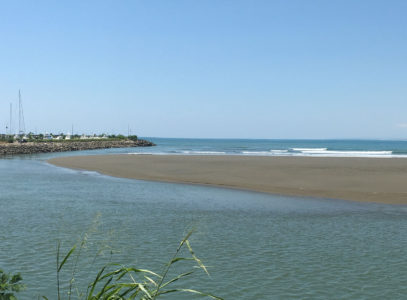Surfing in Quepos and Manuel Antonio
 Here are my favorite two spots to surf around Quepos. There are other beach breaks and river mouth breaks, but they generally close out when it is big or if it is low tide. I will share the best tide and time of year to surf them, plus which swell angle works best.
Here are my favorite two spots to surf around Quepos. There are other beach breaks and river mouth breaks, but they generally close out when it is big or if it is low tide. I will share the best tide and time of year to surf them, plus which swell angle works best.

In the center is the Quepos River mouth. At one time I feared paddling out there due to the runoff from the town, but now it seems to be better. That being said I like to paddle out at low tide when the outflow is minimal, and during the dry season months of March and April. I didn’t mention December to February since during those months it’s usually too small to surf. When it is on, there is a left that breaks close to the rocks and goes for about 150 meters, and another left on the north side of the river mouth that breaks 200-300 meters depending on the size and angle of the swell. It is best with a South-Southwest angle—too much West and the wave closes out, too much South and it passes by the end of the jetty from the marina. It needs to be 2 to 3 feet overhead at the beach breaks to make chest high waves at the river mouth. Luckily most of the time this wave is uncrowded, but if you see some locals out be sure to give them respect and they will return the favor.
To the south in Manuel Antonio is Playitas. This is the section of beach that starts about a half kilometer north of the national park, and is located in front of the Hotel Karahe. The winding drive down to the break is hard to find (look for the Barba Roja Restaurant), but if you do then you can park right on the sand or if crowded on the side of the road. If you can’t find it, then park at the south end of the beach and walk north until you pass a small island just off the beach, and then another two meter rock sticking out from the surf about 50 meters out into the lineup. You can paddle out there or all the way to the point, and the waves break both left and right.
It takes a South to Southwest swell, but the shape can be imperfect due to the refractions of swell off the bigger islands off the coast. As a beach break, it works better right around high tide, and this is good since that also covers up some of the boulder sized rocks that sit right offshore in the middle of the break. This wave is very crowded at times since it generally is 1-2 feet bigger than other parts of Manuel Antonio, and the rocks provide a more hollow takeoff and some barreling sections. The best months are April to June when consistent Southern Hemisphere swells push up from Peru and across from Australia. I would not surf there as a beginner since collisions can happen with an aggressive lineup and broken boards are expensive.
There are fun spots to surf around the country, no matter your level of experience on a board. Please visit our website CRsurf.com and send us a note to help you find the best waves for your adventure.
